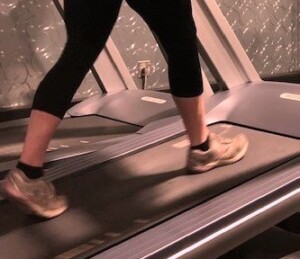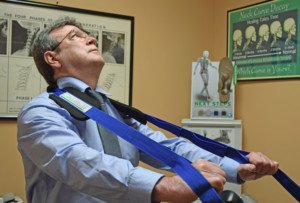
Walking on an inclined treadmill can cause shin splints, but there are several solutions to this problem.
First off, don’t assume that incline walking is not impacting enough to cause shin splints. You need not be a runner to suffer from this common problem.
“Shin pain, often referred to as shin splints, in most cases results from a repetitive strain to the tibialis anterior muscle(s) along the tibial or shin bone,” says Dr. Tom Carpenter, corrective exercise specialist, certified personal trainer and chiropractor, inventor of Stand Corrected™, a portable harness-like stretching tool that helps alleviate back, neck and shoulder pain.
Features of Shin Splints
• Muscles, tendons and the soft tissue that cover the shin bone develop irritation or inflammation.
• Pain can occur on the inside edge of one’s shin bone.
• Pain may occur strictly during the offending activity in some cases.
• In other cases it may persist beyond the particular activity, including at rest.
• Risk factors: sedentary person rushing into too much or too intense walking; walking on uneven or downhill surfaces; walking on an incline; overtraining.
• Having flat feet.
Mechanism of Shin Splints
“Assuming there’s no fracture or other pathology, the first thing I would suggest is having the arches of the feet evaluated,” continues Dr. Carpenter.
“I personally use a computerized scanner in my office. I would not rely on those ‘in store’ scanners, as they are not very accurate, in my opinion.
“There are actually three arches in the foot and each one has a specific function during the gait mechanism, to provide stability for the foot, ankle, lower leg (shin), and in fact, the entire body’s movement.
“The medial arch prevents over-pronation upon heel strike. Then, as the foot plants itself, it will tend to roll out, or supinate.
“The lateral arch is designed to prevent excessive supination. Finally, as the foot pushes off for propulsion, the metatarsal arch maintains balance and stability.
“If any or all of these arches are compromised, shin splints can result.”
Treatment for Shin Splints Caused by Treadmill Incline
Dr. Carpenter recommends flexible custom-fit orthotics for patients with arch problems or flat feet.
Custom-fit orthotics aren’t cheap and take time to make. In the meantime you can try Birkenstock arch supports. They are pricey but quite effective.
“If the arches are not the problem, make sure your workout shoes are providing proper support,” continues Dr. Carpenter.
When walking for exercise, you should be wearing shoes designed for walking.

Shutterstock/YanLev
When trying on walking shoes at the store, shop late in the day, when feet are at their largest. Feet swell as the day goes on. Never buy shoes in the morning.
“Also, excessive dorsiflexion of the foot with increased incline can aggravate the tibialis anterior muscle,” says Dr. Carpenter.
Dorsiflection refers to the bending upward of the foot towards the shin, as you’d do, for intance, when putting on a sock. The angle between the top of the foot and the shin gets smaller with steeper grades.
“Reduce the angle of incline on the treadmill to see if that reduces the discomfort,” says Dr. Carpenter.
Don’t think for a second that holding onto the treadmill, to lessen this angle, is a smart solution for shin splints.
Though holding on will probably relieve some or even all of the pain, you can end up with new problems from holding onto a treadmill, including repetitive stress injury in the hips and a fake workout that undermines your fitness goals.
Instead of relying on holding onto the treadmill to treat shin splints, follow the treatment protocols described in this post and lower the incline to reduce the dorsiflexion.
“Other short-term solutions would be to use ice on the point of pain, rest and pay attention to make sure that you’re not simply overtraining,” says Dr. Carpenter.
Overtraining, indeed, can lead to shin splints. You may want to replace one of your multi-weekly treadmill incline sessions with a step class, aerobics class or pedaling exercise. If jogging on a flat surface feels fine, then do that.
In more severe cases, avoid the treadmill incline altogether to give the injury a chance to heal.
Return to incline walking very gradually, perhaps only five minutes at a time at a slower pace and lower incline than pre-injury.
Prevention of Shin Splints from Walking a Treadmill Incline
• Strength train. Many walkers don’t do any weightlifting. The best strength training for the legs is the squat, leg press, deadlift and lunge (below).

Shutterstock/Artsplav
• Don’t slam your feet down on the treadmill, whether you walk or run.
Though a slamming foot strike is uncommon with an incline, it can occur during walking or jogging on a zero angle surface.
With the slamming, the user sounds like a buffalo and can be heard clear across the gym! Ask yourself if you’re a foot slammer.
This can cause other injuries in the foot as well, including plantar fasciitis.
• Finally, do plyometrics – but only after you’ve completely healed.

Photo credit: Aleesia Forni


























